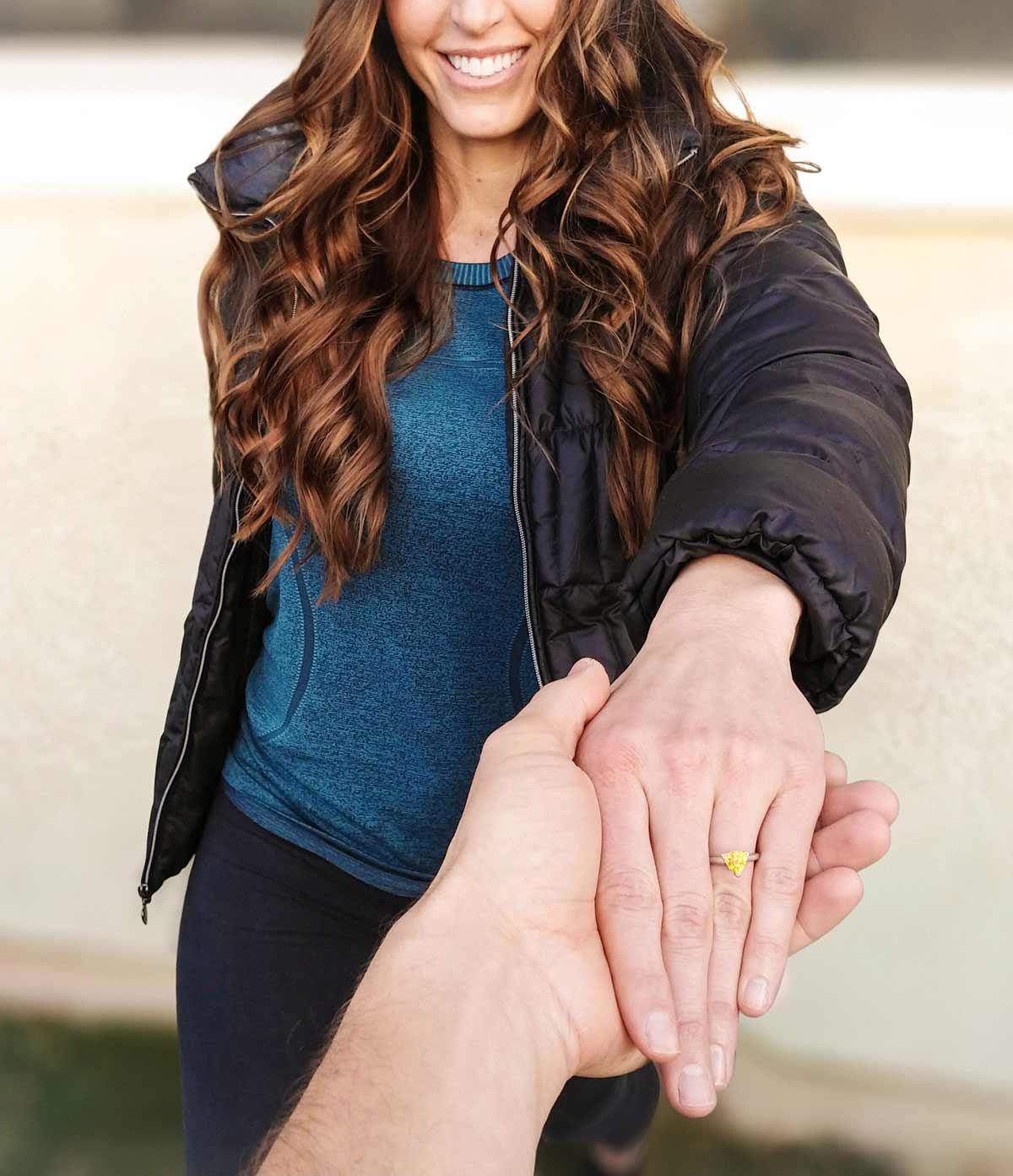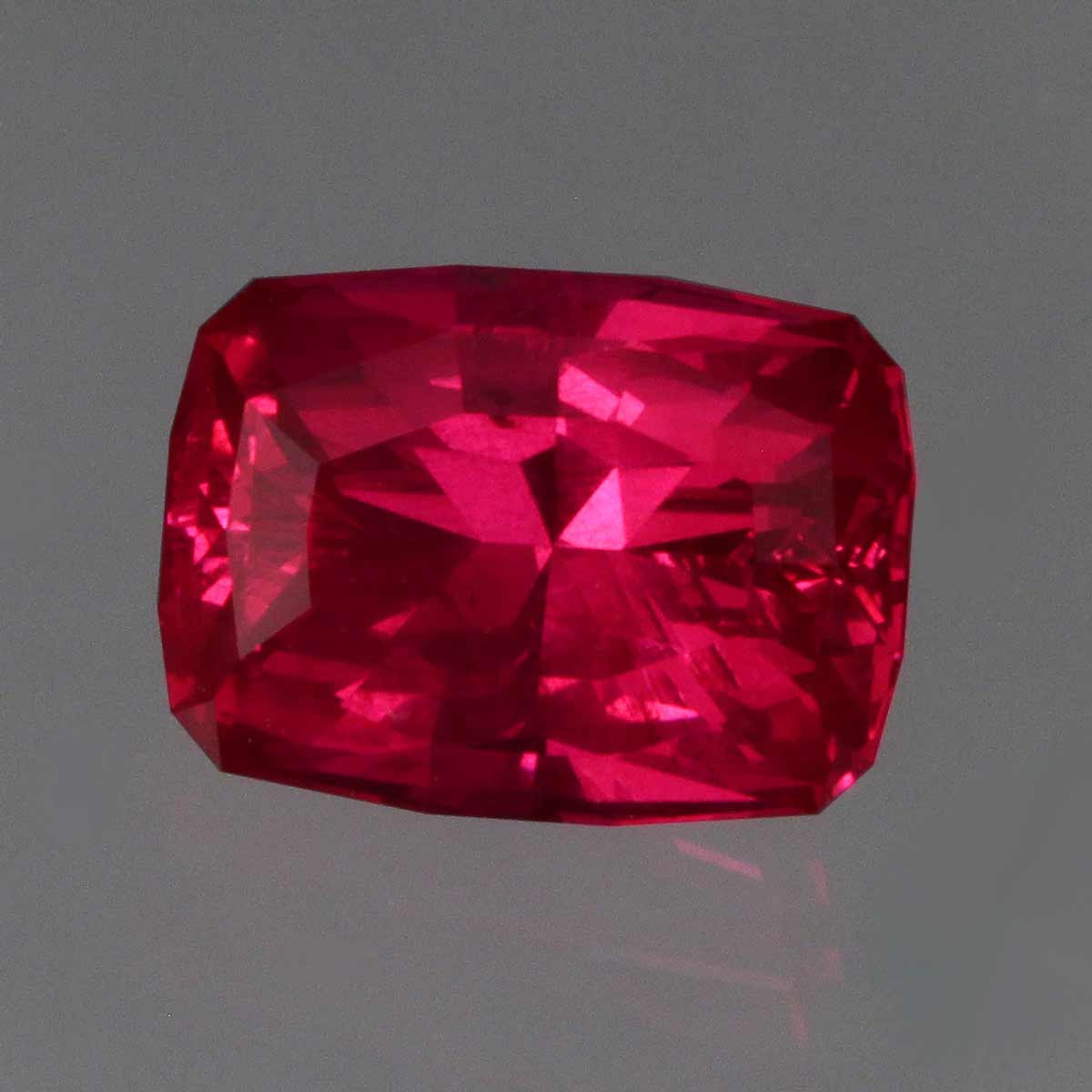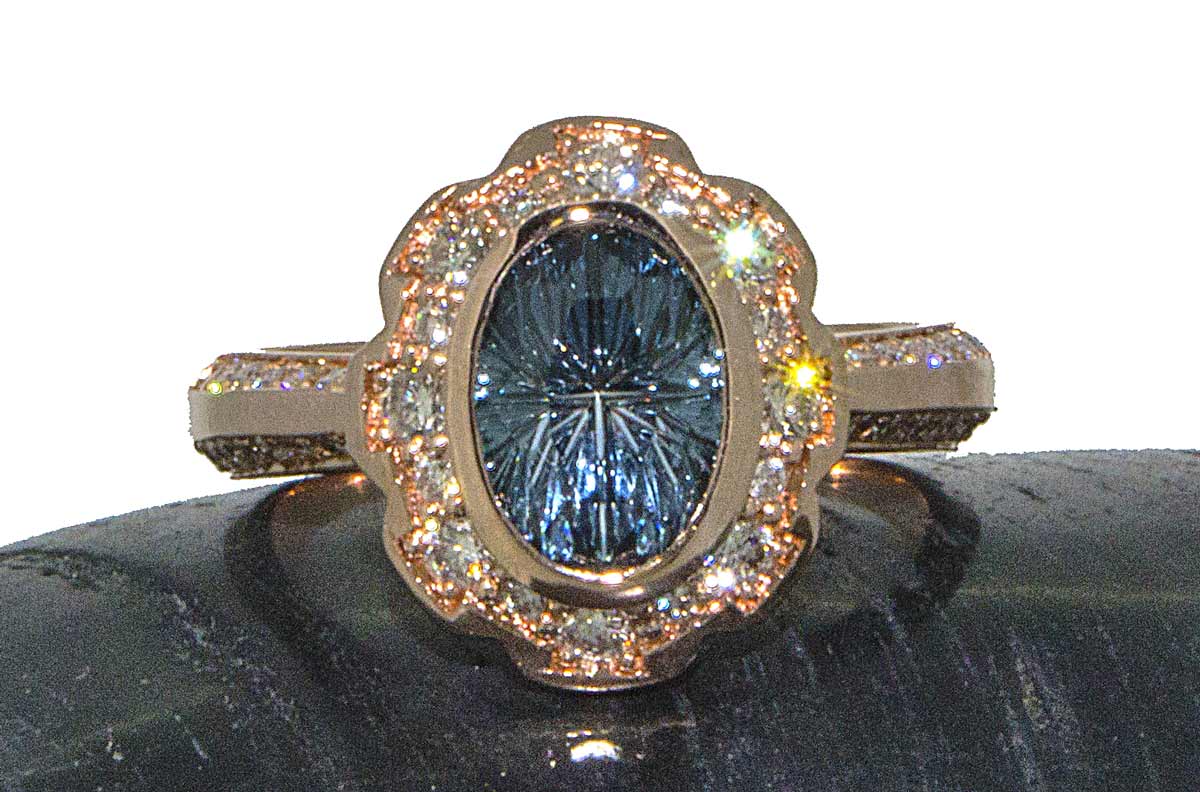

Ruby is red, and sapphires come in many colors!
Photo: Sapphires and ruby cut by John Dyer Gems
Rubies and sapphires may look very different, but they're the same mineral - corundum, which is just a combination of aluminum and oxygen (Al203).
Pure corundum is colorless, but when traces of chromium are present, corundum can be red, and is then called "ruby," a term derived from the Latin ruber meaning red. Traces of iron and vanadium can make corundum blue, and then it is named sapphire, which is derived from the Greek word sáppheiros denoting the blue stone lapis lazuli. (In ancient times almost any blue gem was called sapphire, only more recently has the advance of gemological science allowed us to more easily differentiate each kind of gem mineral from the others of the same color.)
Corundum comes in just about every color imaginable, orange, yellow, green, pink, purple, violet, brown, gray, and black. Occasionally, corundum is even bi-colored or multi-colored. Some stones change color when viewed outdoors in the sun; others display stars formations due to microscopic crystals arranged in a hexagonal pattern inside them. Any corundum that is not red is called sapphire. However, to avoid confusion, sapphires that are not blue include their color in their name. For example, sapphires that are yellow are called "yellow sapphires." Blue sapphires, on the other hand, are in most cases simply called sapphires.

When microscopic rutile crystals inside the sapphire or ruby are numerous enough and correctly distributed through the gem along its hexagonal crystal faces you can get a 6 ray "star" when you cut the gem in the right direction in a smooth "cabochon" style. This star is a reflection of the light off the tiny internal inclusions in the gem.
Photo: Purple star sapphire from Madagascar
For centuries, rubies and sapphires have been considered regal gems. In ancient India, the ruby was called the "king of precious stones." The glowing red hue suggested an inextinguishable flame burning within the stone, which was believed to give it special power.
In Europe, the ruby was used for coronation rings and in the crowns of Christian monarchs. Besides representing royal power rubies served as a remembrance of the suffering and blood of Christ and so illustrated His divine love for the world. By extension the ruby also was thought to symbolize the sacrifice of sovereigns committed to serving their country and their people.
Sapphires were often worn by kings and queens around the neck for good luck. Considering the high regard British royalty has had for corundum, it's not surprising that Princesses Anne and Diana each received a sapphire engagement ring, and Fergie the Duchess of York received one with a ruby. Corundum's presence in engagement rings hasn't been limited to royalty. Actress Liz Taylor and Luci Baines Johnson Nugent (daughter of US president Lyndon Johnson) are two other well-known women who have received sapphire engagement rings. The bridal ring of Jenna Bush, (daughter of US president George Bush) featured sapphires along with an heirloom diamond.

She said yes!
It isn't only royalty or the rich and famous that say "I do!" with a ring holding a sapphire or ruby. Many of the sapphires and rubies we cut here at John Dyer Gems go into engagement rings where they are valued for their beauty, durability, tradition and uniqueness. If your relationship is unique why not have a unique representation of your love also?
Photo credit: Client provided engagement photo featuring a ring with one of our Super Trillion™ cut yellow sapphires.
Rubies and sapphires are not only royal gems, they are considered sacred as well by many. In the Catholic church, sapphires have been used in the rings of bishops and cardinals. Their blue color is often used to symbolize heaven. Traditionally, Buddhists have believed sapphires signified friendship and steadfastness.
Perhaps you're wondering why rubies and sapphires have been so revered throughout history. It's partly because of their rich looking colors, which allow them to look like jewels even when they're cut into simple rounded stones (called cabochons) with no geometric facets. A diamond cut this plain would look rather drab.
Many people don't realize that each ruby or sapphire is a blend of two colors. For example, in one direction a ruby crystal may look purplish and in another, orangey. But when you view it as a whole once the gem is cut, you see a sumptuous red.

Ruby cushion-cut by John Dyer Gems
To top it all off, the ruby is blessed with a red aura, technically identified as fluorescence. It's usually in the sun that you see this distinctive glow. But the ancient Burmese said it could even be seen in the dark. According to one legend, a king in Burma had rubies that glowed so brightly, they lit up the city at night.
Rubies have used their color to full advantage. They grab your attention with it, and inspire passion. Their fiery hue helps rubies compensate for the fact that their average size is generally less than other gemstones. Their small size is not necessarily a detriment. It emphasizes the fact that they're very rare. As a result, rubies can bring unusually high prices. The highest per-carat price was paid at a Christie's St. Moritz auction on Feb 15, 2006 when an 8.62 ct cushion-cut ruby mounted in a Bulgari ring sold for $3,637,480. (per carat cost, $425,000). The only diamonds that have brought such high per-carat prices are those that are blue, red, orange, strong pink, or green. Sapphire and ruby are far rarer than diamond. Table 1.1 summarizes some record-setting rubies and sapphires.
Table 1.1 Highest prices paid at auction for rubies and sapphires (Listed in order of highest per-carat price)
| Gemstone Description |
Carat Weight |
Date of Sale |
Total Price |
Per-Carat Price |
| Sunrise Burma ruby |
25.59 ct |
May 2015 |
$32.420,000 |
$1,266,901 |
| Auction record total and per-carat price for ruby |
||||
| Graff Burma Ruby |
8.62 ct |
Nov. 2014 |
$8.570,000 |
$994,040 |
| Auction record per-carat price for a single ruby at the time of sale |
||||
| "Jewel of Kashmir" |
27.68 ct |
Oct 2015 |
$6,745,688 |
$243,703 |
| Auction record total price for a single sapphire |
||||
| Kashmir sapphire |
35.09 ct |
May 2015 |
$7,398,522 |
$209,689 |
| Auction record per-carat price world record for a single blue sapphire |
||||
| Rockefeller Sapphire |
62.02 ct |
April 2001 |
$3,031,000 |
$48,871 |
| Total and per-carat price world record for a single blue sapphire before April 2007 |
||||
| Star ruby cabochon |
26.40 ct |
Nov 2012 |
$1,247,412 |
$63,871 |
| Auction record for a star ruby |
||||
Sources: Richard Hughes at www.ruby-sapphire.com, www.christies.com, AGTA ePrism

Message from a client:
This is Jan and Jeter Case from J.C. Jewelers in Jackson Hole, Wyoming. We bought a beautiful 2.30 carat natural color Montana sapphire with your custom StarBrite™ cut back in June. Jeter handcrafted a custom rose gold setting with diamond accents for a truly one of a kind piece. Our eldest son proposed with it in Italy and she said yes! She is not really a jewelry girl but thanks to your help she is on her way-she loves her ring! Thank you for helping us find a unique stone to make this the most important (and incredible) ring we have ever made.
We love notes from happy clients like this. :)
We are also happy to direct you to a jeweler such as Jeter to help make your dream ring once you have selected one of our gems to design the ring around!
Diamond is several times harder than corundum. However, no other gemstone is harder than a ruby or sapphire. This is one reason why man-made ruby and sapphire is used for tips in ballpoint pens, crystals and jewel bearings in fine watches, meters and aircraft instruments. Since 1960, synthetic ruby has been used as a core in lasers.
In one instance, a sapphire was even used as a doorstop. An Australian gem buyer paid around $24 for a rough sapphire about the size of a chicken egg (1156 carats). It had originally been found by a little boy and used as a doorstop. Later, the gem buyer sold the stone to an American who cut it into a 733-carat star sapphire called the "Black Star of Queensland". According to one report, its value is estimated at over $267,000.
Very large rubies or sapphires may be impractical to wear as jewelry, so sometimes if they are translucent to opaque, they are carved into attractive figurines. A select few are sculptures of famous people like Confucius, George Washington and Dr. Martin Luther King.
For example, Confucius was carved from a multi-colored sapphire in such a way that his head is white, his trunk and arms blue, and his legs yellow. In the 1950's, four of the world's largest sapphires were carved into US presidential busts by James and Harry Kazanjian. They are now on display in the oval office. Dr. King was carved from a rough sapphire weighing 4180 carats, and the final 3294-carat sculpture of him was unveiled in 1984.
Rubies and sapphires don't have to be big to be highly valued. According to corundum specialist Richard Hughes, "Any untreated ruby of quality above two carats is a rare stone; untreated rubies of fine quality above five carats are world-class pieces." It is logical that larger rubies would be rarer than large sapphires since only one color of corundum can be classified as a ruby, while all other colors are called sapphire, this naturally results in a greater availability of sapphire relative to ruby. The corundum family has a lot to offer, beauty, strength, variety, mystery, romance. So consider buying rubies and sapphires. Let them add some exotic color to your life.
By Renée Newman GG, author of the Gemstone Buying Guide: How to Evaluate, Identify, Select & Care for Colored Gems. More information about Renée and her books is available at www.ReneeNewman.com